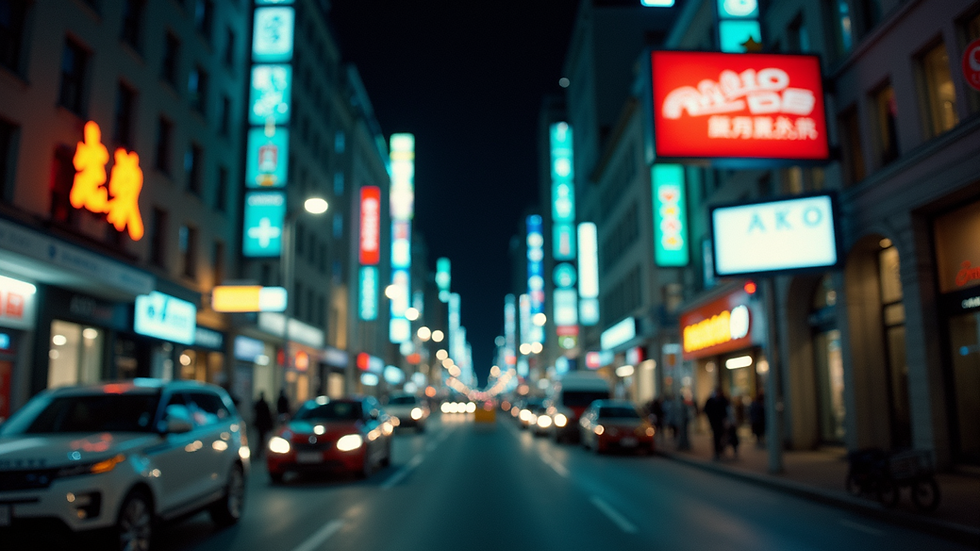How Lighting Enhances the Effectiveness of Signage
- cmyk graphics
- Sep 22
- 4 min read
In the world of advertising and branding, signage plays a crucial role in attracting attention and conveying messages effectively. However, the impact of signage is significantly amplified when combined with proper lighting. Lighting not only makes signs visible during low-light conditions but also enhances their aesthetic appeal and readability. This article explores how lighting enhances the effectiveness of illuminated signage, providing practical insights and examples to help businesses make the most of their signage investments.
The Role of Lighting in Illuminated Signage
Lighting transforms ordinary signs into eye-catching displays that stand out in any environment. Whether it is a storefront, a billboard, or directional signage, the right lighting can make a huge difference in visibility and engagement.
Visibility at Night: One of the primary benefits of lighting is that it ensures signs are visible after dark. This extends the hours during which a business can attract customers.
Highlighting Key Information: Lighting can be used to emphasize important parts of a sign, such as a brand name, logo, or promotional message.
Creating Ambiance: Different lighting colors and intensities can evoke specific moods or feelings, aligning the signage with the brand’s identity.
Improving Readability: Proper illumination reduces glare and shadows, making text and graphics easier to read from a distance.
For example, a retail store using bright LED lighting on its signage can attract more foot traffic during evening hours compared to a non-illuminated sign that fades into the darkness.

Benefits of Using Illuminated Signage
Illuminated signage offers several advantages over traditional non-lit signs. These benefits contribute to better brand recognition, customer engagement, and ultimately, increased sales.
Enhanced Brand Visibility: Illuminated signs are visible from greater distances and in various weather conditions, ensuring your brand is always noticed.
24/7 Advertising: Unlike non-lit signs, illuminated signage works around the clock, promoting your business even when it’s closed.
Energy Efficiency: Modern lighting technologies like LEDs consume less power and have longer lifespans, making illuminated signs cost-effective.
Customization Options: Lighting allows for creative designs, including color changes, animations, and dimming features that can adapt to different times of day or events.
Safety and Security: Well-lit signs contribute to a safer environment by illuminating walkways and entrances, deterring vandalism and accidents.
Businesses looking to upgrade their signage can explore a variety of lighting options to suit their needs and budgets. For instance, neon lights offer a retro aesthetic, while LED lights provide versatility and energy savings.

What is a Backlight Sign Board?
A backlight sign board is a type of illuminated signage where the light source is placed behind the sign face, creating a glowing effect that enhances visibility and appeal. This method is popular for its clean, modern look and excellent readability.
How It Works: The light is diffused through a translucent panel, evenly illuminating the graphics or text on the sign.
Materials Used: Common materials include acrylic or polycarbonate panels that allow light to pass through while protecting the internal lighting components.
Applications: Backlight sign boards are widely used in retail stores, restaurants, airports, and corporate offices due to their professional appearance.
Advantages: They provide uniform lighting without hotspots or shadows, making the sign easy to read from various angles.
For example, a restaurant might use a backlight sign board to display its logo and menu outside, ensuring customers can see it clearly even at night or in poor weather.

Practical Tips for Optimizing Lighting in Signage
To maximize the effectiveness of illuminated signage, consider the following practical recommendations:
Choose the Right Light Source: LEDs are preferred for their brightness, energy efficiency, and longevity. Avoid outdated bulbs that consume more power and require frequent replacement.
Consider Color Temperature: Warm white lights create a welcoming atmosphere, while cool white lights offer a modern, crisp look. Match the lighting color to your brand personality.
Use Dimmers and Timers: Adjust lighting intensity based on the time of day to save energy and reduce light pollution.
Ensure Proper Placement: Position lights to avoid glare or shadows that can obscure the sign’s message.
Maintain Regular Cleaning: Dust and dirt can reduce light output, so keep your signage clean for optimal performance.
Incorporate Motion Sensors: For signs in less trafficked areas, motion-activated lighting can save energy while still providing visibility when needed.
By implementing these tips, businesses can ensure their signage remains effective and attractive, drawing in customers and reinforcing brand identity.
The Impact of Illuminated Signage Boards on Business Success
Investing in illuminated signage boards can significantly boost a business’s visibility and customer engagement. These signs are not just functional but also serve as powerful marketing tools.
Increased Foot Traffic: Well-lit signs attract attention and invite potential customers inside, especially in busy commercial areas.
Brand Differentiation: Unique lighting designs help businesses stand out from competitors, making their brand more memorable.
Improved Customer Experience: Clear, visible signage helps customers find locations easily, reducing frustration and enhancing satisfaction.
Cost-Effective Advertising: Compared to other forms of advertising, illuminated signage offers continuous exposure with minimal ongoing costs.
For example, a boutique hotel using illuminated signage boards can attract tourists looking for accommodation at night, increasing bookings and revenue.

Enhancing Signage with Technology and Innovation
The future of illuminated signage is bright, with technological advancements offering new possibilities for businesses.
Smart Lighting: Integration with IoT allows signs to change brightness or color based on ambient light or time of day.
Digital Displays: LED screens can display dynamic content, promotions, or interactive messages.
Solar-Powered Lighting: Eco-friendly options reduce energy costs and appeal to environmentally conscious customers.
Augmented Reality (AR): Combining signage with AR can create immersive brand experiences.
By embracing these innovations, businesses can keep their signage fresh, engaging, and aligned with modern consumer expectations.
Lighting is a powerful tool that enhances the effectiveness of signage in multiple ways. From improving visibility and readability to creating ambiance and boosting brand recognition, illuminated signage is an investment that pays off. By understanding the different lighting options and applying best practices, businesses can ensure their signs not only attract attention but also communicate their message clearly and memorably.





Comments